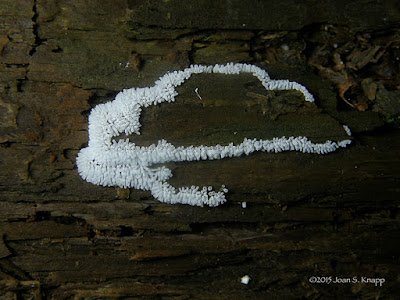June 12th. (Continued from…) When I visited Fort Yargo State Park in mid-February, there were few signs of Spring. The only wildflower plants that were obvious were the leaves of Cranefly Orchids (Tipularia discolor) that I found in many places.
The route… I’ve described it here, here, here, and here This walk doesn’t have the variety of wildflowers as my other
walk from the Group A Shelter to the Old Fort but it does have some gems. One
of the Smallflower (Asimina parviflora) had developed fruit that, unfortunately,
it had lost; the Pink Lady’s Slipper (Cypripedium acaule) Orchids had bloomed,
and some Green Adder’s-mouth (Malaxis unifolia) Orchids were blooming.
Before I headed down the trail from the dam, I photographed
the…
Queen Anne’s Lace (Daucus
carota) flowers that were blooming near the Lanceleaf
Coreopsis.
A Common Whitetail (Plathemis lydia) dragonfly was well-camouflaged against pine needles on a
fallen branch.
At the beginning of the return trail I saw another flower
that was very similar in overall appearance to the Queen Anne’s Lace, but this
was different, it was
Hairy Angelica (Angelica venenosa). Both Queen Anne’s Lace and Hairy Angelica belong
to the family Apiaceae and have compound umbel flowers, however individual
florets and the leaves of these plants differ.
A
close up view of the flowers of Queen Anne’s Lace (Top) and Hairy Angelica
(Bottom), and the…
Leaves
of Queen Anne’s Lace (Top) and Hairy Angelica (Bottom). I’m glad I didn’t just
walk past the Hairy Angelica without taking a closer look.
The mysterious, unidentified oak galls were still drying up;
there was no sign of anything breaking out of the gall.
Nearby I found a couple of…
Oak Apple Galls, one (Top) older than the other (Bottom).
A Green Arrow Arum (Peltandra virginicus) in bloom. A
dusting of pollen is visible at the base of the flower.
The developing seed capsules on the Perfoliate Bellwort
(Uvularia perfoliata) looked really healthy.
Nearby insects had been feasting on Virginia Creeper (Parthenocissus quinquefolia) leaves.
The Green Adder’s Mouth Orchids (Malaxis unifolia) were
still blooming.
It was clear that a number of flowers had been fertilized. I’s
always wondered why this was called the Green Adder’s-mouth Orchid but I could
see the adder’s mouth in these images.
The Pipsissewa (Chimaphila maculata) plants by the trail just beyond the orchids were
developing seed capsules.
At the top of The Hill, I found some…
Wolf’s Milk (Lycogala epidendrum) slime mold fruiting bodies, and more…
Coral Slime (Ceratiomyxa
fruticulosa) on a rotting log.
Near
the top of The Hill,
Blue-fronted Dancers (Argia apicala) were dancing in the sun
on the trail.
Common Buckeyes (Junonia coenia) were soaking up the sun out on the open trail back to the
parking lot.
I thought this walk was going to be snake-free, but as I
made my way down the hill to the final flat section of trail, I encountered
this…
four-foot long Eastern Kingsnake (Lampropeltis getula
getula) just hunting along the embankment at the side of the trail. It ignored
me and several other people who came by, and finally slithered its way up the
embankment and off into the woods.
In the
final open section on the trail, Hoary Mountainmint (Pycnanthemum incanum) was blooming.
Once again, and interesting walk
that I hadn’t anticipated.
Related posts:
- Winter
Walk: Fort Yargo State Park – Section B To The Dam (Part 1)





















































